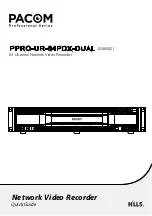
P9415-R-EVK Evaluation Kit
R16UH0015EU0100 Rev.1.0
May 27, 2021
Page 19
In the Extended Power Profile, there are two methods of foreign object detection (FOD). One is by measuring
the system quality factor before entering the power transfer phase, and the other is to measure the power loss
difference between the received power and the transmitted power during the power transfer phase. Before
entering the power transfer phase, the P9415-R sends a reference Q-factor (default 30) in the negotiation phase.
The transmitter measures the Q-factor on its coil and compares it with the reference Q-factor provided by the
P9415-R. If the difference is large, the transmitter presumes that there is a foreign object (FO) between the Tx
and Rx and shuts down. The power loss foreign object detection method is used in both the Extended Power
Profile (EPP) and the Basic Power Profile (BPP) modes power transfer phase. During the power transfer phase,
the P9415-R continuously sends to the transmitter the amount of power received using the Received Power
Packet (RPP). The transmitter will compare the RPP packet information received from the receiver with its
measured transmitted power. If there is a significant difference, the transmitter presumes that there is a foreign
object (FO) between Tx and Rx that is absorbing the transmitted power and will stop the power transfer to avoid
heating of FO.
12.1 FOD Parameters in Receiver Mode
For a WPC power loss foreign object detection to function effectively, the receiver must account and
compensate for all of their known losses. Such losses, for example, could be due to resistive losses or nearby
metals that are part of the receiver. Because the system accurately measures its power and accounts for all
known losses, it can thereby detect foreign objects because they cause an unknown loss. The WPC
specification requires that a power receiver must report to the power transmitter its received power (PPR) in an
RPP. The maximum value of the received power accuracy
𝑃𝑃
Δ
depends on the maximum power of the power
receiver as defined in below Table.
The power receiver must determine its PPR with an accuracy of ±
𝑃𝑃
Δ,
and report its received power as
PRECEIVED = PPR +
𝑃𝑃
Δ.
This means that the reported received power is always greater than or equal to the
transmitted power (PPT) if there is no foreign object (FO) present on the interface surface.
Table 7. Recommended Maximum Estimated Power Loss
Maximum Power (W)
Maximum
𝑃𝑃
Δ
(mW)
5
350
10
500
15
750
The compensation algorithm includes parameter values that are programmable either internal register or
customer configuration table in MTP. Programmability is necessary so that the calibration settings can be
optimized to match the power transfer characteristics of each particular WPC system to include the power losses
of the transmit and receive coils, battery, shielding, and case materials under no-load to full-load conditions. The
values are based on the comparison of the received power against a reference power curve so that any foreign
object can be sensed when the received power is different than the expected system power.
FOD parameters consist of eight sections. Each section is divided by output current and consists of gain and
offset to compensate for Rx internal power loss; each section is also adjusted for Reported Rx power. The
following comprises the Rx load current ranges for the FOD sections.
■
FOD section [0] is from 0mA to section 0 current mA
■
FOD section [1] is reserved
■
FOD section [2] is from section 0 current mA to 351mA
■
FOD section [3] is from 352mA or section 0 671mA
■
FOD section [4] is from 672mA to 863mA
■
FOD section [5] is more than 864mA















































